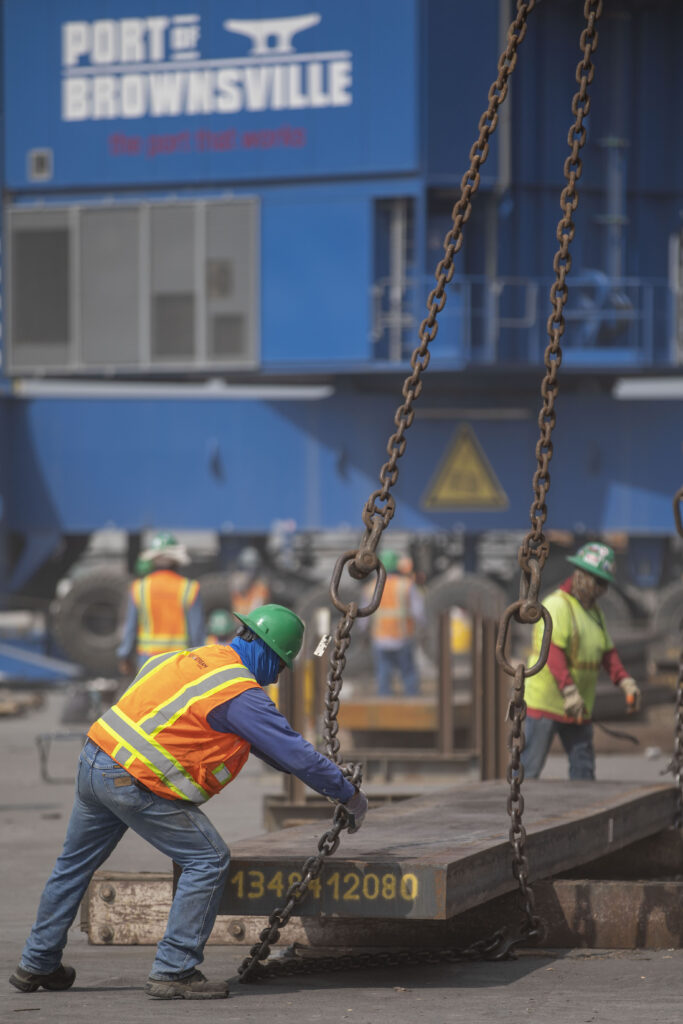The Port of Brownsville was already moving a lot of steel for its biggest steel customer, Ternium S.A., but now that volume has increased significantly thanks to Ternium’s steel mill expansion project in Pesqueria, Mexico.
The upshot is more revenue for the port and more jobs being created at the port, said Eduardo Campirano, port director and CEO. The new Ternium hot-rolled-steel mill, which had been in the works for years, started operations in June, he said.
“What they’re telling us, what we will see this coming year, which for us would be the latter part of this year and the first six months of next year, is they’re going to increase their through-put through the Brownsville port to about 3.6 million tons,” Campirano said. “Last year we did about 2.6 million tons.
“And it will gradually ramp up potentially over the next three to four years — and perhaps sooner — anywhere between 4.6 million to 5.2 million tons a year. So it is a considerable volume of slab coming through the port. It will almost double what our normal through-put would be in any given year.”
Ternium, the largest steel producer in Latin America, is headquartered in Luxembourg. Campirano said the company plans to add galvanization and painted steel lines at Pesqueria, which could mean as much as 6 million metric tons of slab moving through the port annually. Since the new mill began operations, 32 vessels have called on the port to deliver more than 1.6 million metric tons of slab from Brazil and Russia to feed the mill.
The hot-rolled steel that Ternium produces in Mexico is used mainly in the automotive and white appliance or home goods industries.
“That’s a big part of the trade that comes across eventually as a finished product to the United States,” Campirano said.
The port, Brownsville & Rio Grande (BRG) International Railway and OmniTRAX, which manages the short-line railroad, and the port’s stevedoring operation are all investing substantially to handle the additional steel volume, he said.

“All are having to make capital improvements to keep up with this,” Campirano said. “The big deal right now is extending the load yard to be able to handle three 90-car-unit trains if necessary, to have them done all at one time. That means that we could be moving 270 loaded cars out of here three, four, possibly five times a week if necessary as the incremental volume increases. That’s the big focus right now in capital improvements on the ground.”
Slab is moved by rail once it’s been unloaded from a vessel, though coiled steel — the finished product from the mill —mostly moves by truck, he noted.
“That means local trucking companies on both sides of the border … are involved in moving that commodity, so you can see how it helps feed the economy,” Campirano said.
Other infrastructure work in response to increased steel volume includes road improvements and rerouting, relocation of utilities and so on.
“All told right now we estimate between the port and BRG on those physical improvements, it’s going to be about $6 million,” Campirano said.
As for jobs, it takes about 75 stevedores, divided into three to five “gangs,” to unload a vessel loaded with slab and move it to the storage yard or directly onto rail cars, he said, adding that unloading one vessel can take three to four days. As of July 8 five vessels were scheduled to call at the port this month, but that won’t be all for July, Campirano said.

“You can see how those jobs begin to add up,” he said. “Of course with the increased volume of traffic it also means that there’s going to be more revenue. The way we would make our money is through the vessel coming into the port, wharfage, dockage”
Every rail car the BRG handles generates revenue as well, Campirano said, adding that the relationship with Ternium also “creates other opportunities for the region.”
“Obviously down the road if there’s ever going to be a prospect of an automotive facility in the Valley, this is a big plus,” he said. “If there’s ever going to be a prospect of expanding the (waterborne) container service to other areas because of the home goods, this is a plus.
“It has a ripple effect. Ternium has been in the port, a customer of the port, for a long time. We’ve been in the steel trade. We’ve been able to grow with Ternium. This was a sizable investment on their part and the port plays an integral part, and the region plays an integral part, in being able to support their operation.”




